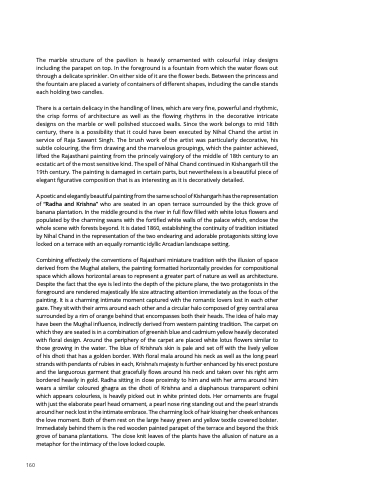Page 166 - Eye of the beholder
P. 166
160
The marble structure of the pavilion is heavily ornamented with colourful inlay designs including the parapet on top. In the foreground is a fountain from which the water flows out through a delicate sprinkler. On either side of it are the flower beds. Between the princess and the fountain are placed a variety of containers of different shapes, including the candle stands each holding two candles.
There is a certain delicacy in the handling of lines, which are very fine, powerful and rhythmic, the crisp forms of architecture as well as the flowing rhythms in the decorative intricate designs on the marble or well polished stuccoed walls. Since the work belongs to mid 18th century, there is a possibility that it could have been executed by Nihal Chand the artist in service of Raja Sawant Singh. The brush work of the artist was particularly decorative, his subtle colouring, the firm drawing and the marvelous groupings, which the painter achieved, lifted the Rajasthani painting from the princely vainglory of the middle of 18th century to an ecstatic art of the most sensitive kind. The spell of Nihal Chand continued in Kishangarh till the 19th century. The painting is damaged in certain parts, but nevertheless is a beautiful piece of elegant figurative composition that is as interesting as it is decoratively detailed.
A poetic and elegantly beautiful painting from the same school of Kishangarh has the representation of “Radha and Krishna” who are seated in an open terrace surrounded by the thick grove of banana plantation. In the middle ground is the river in full flow filled with white lotus flowers and populated by the charming swans with the fortified white walls of the palace which, enclose the whole scene with forests beyond. It is dated 1860, establishing the continuity of tradition initiated by Nihal Chand in the representation of the two endearing and adorable protagonists sitting love locked on a terrace with an equally romantic idyllic Arcadian landscape setting.
Combining effectively the conventions of Rajasthani miniature tradition with the illusion of space derived from the Mughal ateliers, the painting formatted horizontally provides for compositional space which allows horizontal areas to represent a greater part of nature as well as architecture. Despite the fact that the eye is led into the depth of the picture plane, the two protagonists in the foreground are rendered majestically life size attracting attention immediately as the focus of the painting. It is a charming intimate moment captured with the romantic lovers lost in each other gaze. They sit with their arms around each other and a circular halo composed of grey central area surrounded by a rim of orange behind that encompasses both their heads. The idea of halo may have been the Mughal influence, indirectly derived from western painting tradition. The carpet on which they are seated is in a combination of greenish blue and cadmium yellow heavily decorated with floral design. Around the periphery of the carpet are placed white lotus flowers similar to those growing in the water. The blue of Krishna’s skin is pale and set off with the lively yellow of his dhoti that has a golden border. With floral mala around his neck as well as the long pearl strands with pendants of rubies in each, Krishna’s majesty is further enhanced by his erect posture and the languorous garment that gracefully flows around his neck and taken over his right arm bordered heavily in gold. Radha sitting in close proximity to him and with her arms around him wears a similar coloured ghagra as the dhoti of Krishna and a diaphanous transparent odhini which appears colourless, is heavily picked out in white printed dots. Her ornaments are frugal with just the elaborate pearl head ornament, a pearl nose ring standing out and the pearl strands around her neck lost in the intimate embrace. The charming lock of hair kissing her cheek enhances the love moment. Both of them rest on the large heavy green and yellow textile covered bolster. Immediately behind them is the red wooden painted parapet of the terrace and beyond the thick grove of banana plantations. The close knit leaves of the plants have the allusion of nature as a metaphor for the intimacy of the love locked couple.


